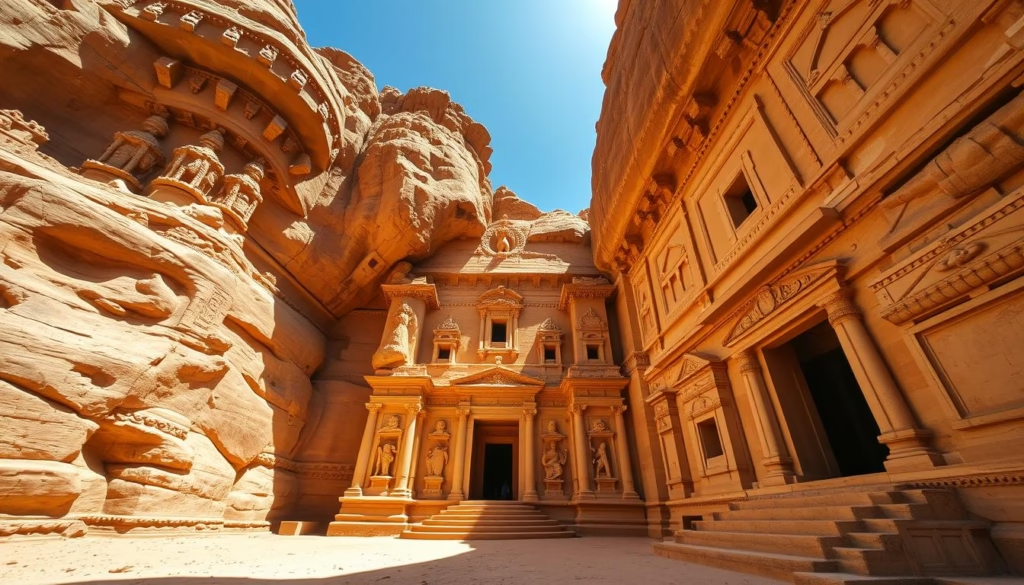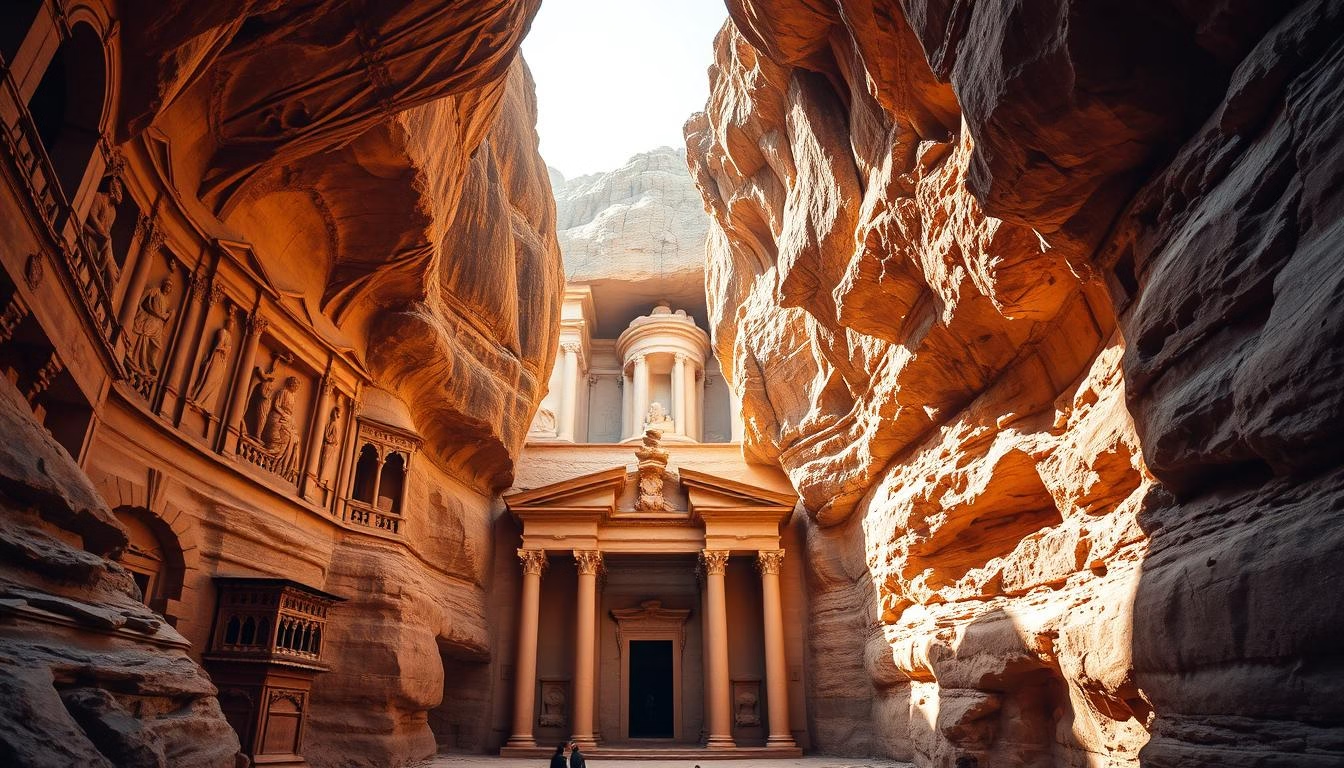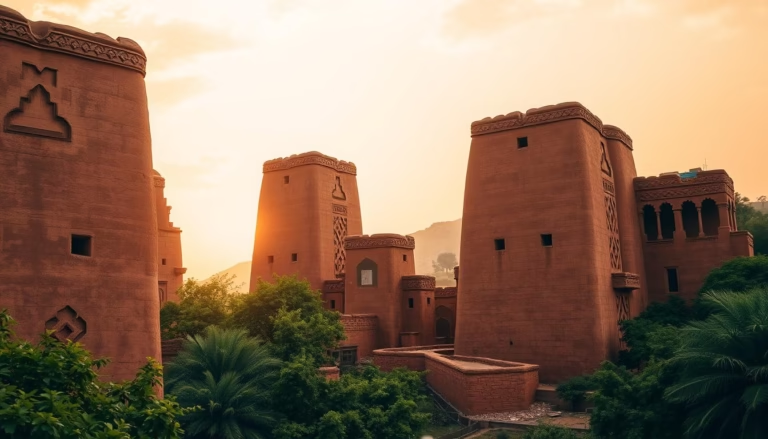Rock Cut Tombs and Temples: History and Significance
Imagine walking through towering stone halls that weren’t built—they were revealed. Ancient civilizations across the globe mastered the art of shaping solid cliffs and mountains into sacred spaces. These monumental creations, carved directly into natural stone, were reserved for society’s most important figures and spiritual practices.
This architectural approach required extraordinary skill. Builders worked backward, removing material to create intricate designs rather than stacking blocks. The process demanded precision, as mistakes couldn’t easily be fixed. Why invest such effort? These spaces symbolized permanence—a way to honor leaders, deities, and beliefs for eternity.
From Egypt to India, these structures reflect cultural values and technological prowess. They blended artistry with engineering, creating spaces that still awe visitors today. Many feature detailed carvings of myths, rituals, and daily life, offering glimpses into ancient worldviews.
Key Takeaways
- Ancient builders carved sacred spaces directly into stone to symbolize lasting cultural and spiritual legacies.
- This architectural method required reverse engineering, starting with solid rock and removing excess material.
- Elaborate carvings often depicted religious stories, historical events, and societal hierarchies.
- Such structures appear globally, showing shared human impulses across different civilizations.
- Preservation challenges highlight the need to protect these irreplaceable historical treasures.
Discovering the Marvel of Rock Cut Architecture
Marvel at structures that grew not upward from the ground but inward from solid stone. This ancient approach flipped standard building logic—instead of stacking materials, artisans subtracted them. The result? Spaces that blended seamlessly with their surroundings, appearing as natural extensions of cliffs and hillsides.

Defining Characteristics and Unique Techniques
Builders worked like sculptors, starting at the top of cliffs and carving downward. This method prevented debris from damaging finished areas below. Temporary staircases and wooden platforms helped workers reach heights safely. They used:
- Chisels for shaping softer sandstone
- Iron picks for tougher stone types
- Water-soaked wedges to split stubborn surfaces
The Art of Carving Directly from Stone
Master planners visualized entire buildings within solid rock before making the first strike. One wrong move could ruin months of work. Clever engineering features like hidden drainage channels and load-bearing pillars showed their deep understanding of materials. These structures weren’t just built—they were revealed, layer by layer, from the earth itself.
Historical Context and Cultural Heritage
Across continents and eras, ancient builders transformed mountains into eternal statements of faith and power. Their work connects us to societies that valued permanence, blending spiritual ideals with technical mastery. These spaces became living records of human achievement, surviving wars, weather, and the passage of centuries.
Ancient Civilizations and Their Legacies
From the deserts of Jordan to the highlands of Ethiopia, cultures developed similar methods to shape stone. The Nabataeans thrived in the 1st century CE, carving Petra’s iconic façades during their golden age of trade. Meanwhile, India’s Kailasa Temple emerged 700 years later as a Hindu marvel, its entire form chiseled from a single cliff.
Buddhist monks began hollowing meditation caves in China during the 4th century. Ethiopia’s Lalibela churches followed in the 1200s, creating sacred spaces that still host pilgrims today. Each project required generations of labor, proving communities would invest decades—even centuries—to honor their beliefs.
Religious and Social Significance in Architecture
These structures served dual purposes: spiritual sanctuaries and political symbols. A king might commission a grand monument to showcase wealth, while priests used the same space for rituals. The Ajanta Caves in India blended art with education, their walls illustrating Buddhist teachings for visitors.
Economic booms often funded these projects. Prosperous cities along trade routes poured resources into monumental works. Skilled artisans turned stone into storytelling canvases, preserving myths and historical events for future generations. Their legacy? A global map of human ingenuity, etched in enduring stone.
Iconic Rock Cut Tombs and Temples
Step into the shadows of colossal stone figures that have guarded sacred grounds for millennia. These architectural wonders showcase humanity’s drive to shape nature into expressions of devotion and dominance. Their creators left behind more than buildings—they carved permanent claims about cultural identity.
Notable Monuments from Jordan to India
Jordan’s ancient city reveals facades chiseled into rose cliffs, a testament to Nabataean traders’ wealth. Far east, the Kailasa Temple at Ellora Caves stuns visitors—this Hindu marvel was scooped from a single basalt hill over 150 years. “It’s like sculpting a mountain instead of molding clay,” notes archaeologist Mira Patel.
Stone Canvases of Authority
Egypt’s Abu Simbel temples feature 66-foot pharaoh statues facing the Nile. Ramesses II designed them to awe travelers and reinforce his god-king status. Similarly, India’s Ellora Caves blended spiritual art with royal propaganda through detailed carvings of deities and dynasties.
Guardians of Global Heritage
UNESCO protects many sites, including Ethiopia’s Lalibela churches and the Ellora Caves complex. These designations help preserve delicate carvings from erosion and tourism. As visitor numbers grow, local communities balance cultural pride with conservation needs—ensuring these stone stories endure for future explorers.
Architectural Details and Carved Intricacies
Ancient artisans turned mountains into galleries of stone mastery, where every chisel mark served a purpose. Their work reveals how material choices and artistic vision combined to create spaces that still take our breath away.
Stone Materials and Structural Innovations
Builders became stone whisperers, adapting techniques to different materials. Soft sandstone allowed delicate floral patterns at Petra, while India’s basalt cliffs demanded iron tools for dramatic temple spires. Clever engineering hid drainage channels behind ornate walls and disguised load-bearing columns as decorative elements.
Interior chambers showcase technical brilliance. The Kailasa Temple’s pillared halls were hollowed from a single hillside, creating spaces where echoes still carry whispers from 1,200 years ago. “They didn’t build upward—they excavated miracles,” remarks conservationist Anika Rao.
Intricate Sculptural Elements and Relief Carvings
Statues served as stone libraries. China’s Longmen Grottoes hold 100,000 Buddhist figures, their faces capturing emotions from serenity to divine joy. Lycian tombs feature reliefs showing warriors’ triumphs, each curl of a beard carved with precision.
Artists used depth play to create drama. Shallow carvings near entrances deepen toward inner chambers, guiding visitors into sacred narratives. At Yungang, 51,000 Buddha figures transition from simple outlines to 3D masterpieces, marking skill levels across generations of craftsmen.
Global Landmarks and Their Significance
Across rugged cliffs and hidden valleys, ancient hands shaped stone into enduring symbols of culture. These landmarks span continents, each telling stories of devotion and innovation. From bustling trade hubs to remote deserts, they reveal how civilizations adapted their tools and visions to stone.
Highlights from Three Iconic Regions
Maharashtra’s Ajanta Caves showcase early Buddhist artistry, with paintings preserved for over 2,000 years. In Turkey’s Dalyan region, Lycian tombs cling to cliffs like stone sentinels, blending Greek designs with local traditions. The Longmen Grottoes near Luoyang amaze with 100,000+ statues, their serene faces reflecting China’s golden age of Buddhist art.
| Site | Location | Key Feature | Cultural Influence |
|---|---|---|---|
| Longmen Grottoes | Near Luoyang, China | Buddhist statues | Tang Dynasty artistry |
| Ajanta Caves | Maharashtra, India | Ancient murals | Buddhist teachings |
| Lycian Tombs | Dalyan, Turkey | Cliffside chambers | Greek-Lycian fusion |
Exploring Lesser-Known Sites
Hegra’s desert monuments prove the Nabataeans weren’t limited to Petra—they mastered arid landscapes too. Cappadocia’s cave churches hide vibrant frescoes in volcanic rock. These examples often lie near forgotten trade routes, waiting to share secrets about how communities thrived in challenging environments.
From Saudi Arabia’s sands to Turkey’s valleys, each site offers unique lessons. They remind us that greatness in stone isn’t just about size—it’s about the boldness to reshape the world, one chisel strike at a time.
Modern Insights on Preserving Ancient Structures
Today’s guardians of stone-carved heritage face a delicate balancing act. Protecting these irreplaceable structures requires blending cutting-edge technology with respect for traditional methods. Climate shifts and visitor footfall now threaten what survived centuries of natural wear.
Restoration Efforts and Tourism Impact
The 1960s relocation of Abu Simbel set a precedent, using modern engineering to save monuments from dam construction. Similarly, Ethiopia’s Lalibela churches now feature protective canopies funded by tourism revenue. Yet increased visitation risks accelerating erosion, as seen at China’s Longmen Grottoes.
Bridging Past and Present in Architectural Conservation
Preservation teams study original Egyptian cult temple techniques to inform their work. Cappadocia’s hidden churches demonstrate how ancient designs addressed security needs—a lesson for modern risk management. Each project becomes a dialogue between eras, ensuring these buildings endure for future generations.






